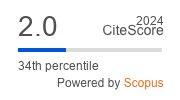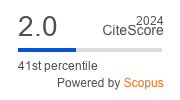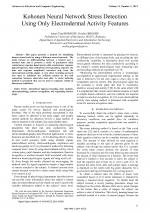| 3/2014 - 9 |
Kohonen Neural Network Stress Detection Using Only Electrodermal Activity FeaturesBORNOIU, I.-V. |
| Extra paper information in |
| Click to see author's profile in |
| Download PDF |
Author keywords
biomedical signal processing, data analysis, electrophysiology, pattern recognition, self organizing feature maps
References keywords
stress(7), electrodermal(6), activity(5), emotion(4)
Blue keywords are present in both the references section and the paper title.
About this article
Date of Publication: 2014-08-31
Volume 14, Issue 3, Year 2014, On page(s): 71 - 78
ISSN: 1582-7445, e-ISSN: 1844-7600
Digital Object Identifier: 10.4316/AECE.2014.03009
Web of Science Accession Number: 000340869800009
SCOPUS ID: 84907310113
Abstract
This paper presents a method for identifying human stress levels by using a Kohonen neural network. The study focuses on differentiating between a relaxed and a stressed state and it presents a series of parameters (skin conductance response signal power, skin conductance response signal frequency, skin conductance level gradient, response rise time and response amplitude) extracted only from the electrodermal activity signal. A very strict recording protocol was used to minimize the artifacts caused by the bad connection between electrodes and skin. A stress inducing method is presented that can be used to replicate results in laboratory conditions. |
| References | | | Cited By «-- Click to see who has cited this paper |
| [1] G. Rigas, C. Katsis, P. Bougia and D. Fotiadis, "A Reasoning-Based Framework for Car Driver's Stress Prediction", in Proc. of 16th Mediterranean Conference on Control and Automation, Ajaccio, Corsica, France, pp. 627 - 632, Jun. 2008.
[2] J. A. Healey, R. W. Picard, "Detecting Stress during Real-World Driving Tasks Using Physiological Sensors", in IEEE Transactions on Intelligent Transportation Systems, vol. 6, issue 2, pp. 156-166, Jun. 2005. [CrossRef] [SCOPUS Times Cited 1698] [3] J. Zhai, A. Barreto, "Stress Detection in Computer Users through Non-Invasive Monitoring of Physiological Signals", in Biomedical Sciences Instrumentation, vol. 42, pp. 495-500, 2006. [4] A. Drachen, L. E. Nacke, G. Yannakakis, A. L. Pedersen, "Correlation between Heart-Rate, Electrodermal Activity and Player Experience in First-Person Shooter Games", in Proc. of the 5th ACM SIGGRAPH, ACM SIGGRAPH Publishers, pp. 49-54, 2009. [CrossRef] [SCOPUS Times Cited 228] [5] D. Kulic, E. A. Croft, "Affective State Estimation for Human-Robot Interaction", in IEEE Transactions on Robotics, vol. 23, issue 5, pp. 991-1000, Oct. 2007. [CrossRef] [SCOPUS Times Cited 198] [6] G. Rigas, C. D. Katsis, G Ganiatsas, D.I. Fotiadis, " A User Independent, Biosignal Based, Emotion Recognition Method", in Proc. of the 11th International Conference, Corfu, Greece, pp. 314-318, 2007. [CrossRef] [SCOPUS Times Cited 68] [7] B. Wolfram, Electrodermal Activity, Springer US, 2nd ed., 2012. [CrossRef] [SCOPUS Times Cited 1734] [8] M. E. Dawson, A. M. Schell, D. Filion, "The Electrodermal System", in Handbook of Psychophysiology 3rd ed., New York: Cambridge University Press, 2007. [CrossRef] [9] S. Schmidt, R. Schnider, M. Binder, D. Burkele, H. Walach, "Investigating Methodological Issues in EDA-DMILS: Results from a Pilot Study", Journal of Parapsychology, vol. 65, pp. 59-82, 2001. [10] R. Henriques, A. Paiva, C. Antunes, "On the Need of New Methods to Mine Electrodermal Activity in Emotion-Centered Studies", in 8th International Workshop, ADMI 2012, Valencia, Spain, pp. 203-215, Jun. 2012. [CrossRef] [SCOPUS Times Cited 21] [11] R. Henriques, A. Paiva, C. Antunes, "Accessing Emotion Patterns from Affective Interactions Using Electrodermal Activity", in 2013 Humaine Association Conference on Affective Computing and Intelligent Interaction (ACII), Geneva, pp. 43-48, Sept. 2013. [CrossRef] [SCOPUS Times Cited 20] [12] C. Kirschbaum, K. M. Pirke, D. Hellhammer, "The 'Trier Social Stress Test' - A Tool for Investigating Psychobiological Stress Responses in a Laboratory Setting", in Neuropsychobiology, no. 28, pp. 76-81, 1993. [13] M. V. Thoma, R. La Marca, R. Bronnimann, L. Finkel, U. Ehlert, U.M. Nater, "The Effect of Music on the Human Stress Response", in PLoS ONE, vol. 8, 2013. [CrossRef] [SCOPUS Times Cited 293] [14] S. Schmidt, H. Walach, "Electrodermal Activity (EDA) - State-of-the-Art Measurement and Techniques for Parapsychological Purposes", in Journal of Parapsychology, vol. 64, pp. 139-163, 2000. [15] I. V. Bornoiu, O. Grigore, "A Study about Feature Extraction for Stress Detection", 2013 8th International Symposium in Advanced Topics in Electrical Engineering (ATEE), Bucharest, Romania, May 2013. [CrossRef] [SCOPUS Times Cited 29] [16] K. Kim, S.W. Bang, S.R. Kim, "Emotion Recognition System Using Short-Term Monitoring of Physiological Signals", in Medical and Biological Engineering and Computing 2004, vol. 42, pp. 419-427, 2004. [CrossRef] [SCOPUS Times Cited 798] [17] T. Cover, P. Hart, "Nearest neighbor pattern classification", in IEEE Transactions on Information Theory, vol. 13, issue 1, pp. 21-27, January 1967. [CrossRef] [SCOPUS Times Cited 12508] [18] T. Kohonen, "The Self-Organizing Map", Proceedings IEEE, vol. 78, no. 9, pp. 1464-1479, Sept. 1990. [CrossRef] [SCOPUS Times Cited 6825] [19] T. Kohonen, Self-Organizing Maps, Springer-Verlag, Berlin, 1995. [CrossRef] [20] S. Haykin, Neural Networks. A comprehensive foundation, Second Edition, Prentice Hall, 1999. [21] R. Rojas, Neural Networks. A systematic introduction, Berlin, 1996. [22] M. Su, T. Liu, H. Chang, "Improving the Self-Organizing Feature Map Algorithm Using an Efficient Initialization Scheme", in Tamkang Journal of Science and Engineering, vol.5, no.1, pp. 35-48, 2002. [23] I. T. Jolliffe, Principal Component Analysis, Springer Series in Statistics, 2nd ed., Springer, NY, 2002. Web of Science® Citations for all references: 0 SCOPUS® Citations for all references: 24,420 TCR Web of Science® Average Citations per reference: 0 SCOPUS® Average Citations per reference: 1,018 ACR TCR = Total Citations for References / ACR = Average Citations per Reference We introduced in 2010 - for the first time in scientific publishing, the term "References Weight", as a quantitative indication of the quality ... Read more Citations for references updated on 2025-07-02 04:35 in 94 seconds. Note1: Web of Science® is a registered trademark of Clarivate Analytics. Note2: SCOPUS® is a registered trademark of Elsevier B.V. Disclaimer: All queries to the respective databases were made by using the DOI record of every reference (where available). Due to technical problems beyond our control, the information is not always accurate. Please use the CrossRef link to visit the respective publisher site. |
Faculty of Electrical Engineering and Computer Science
Stefan cel Mare University of Suceava, Romania
All rights reserved: Advances in Electrical and Computer Engineering is a registered trademark of the Stefan cel Mare University of Suceava. No part of this publication may be reproduced, stored in a retrieval system, photocopied, recorded or archived, without the written permission from the Editor. When authors submit their papers for publication, they agree that the copyright for their article be transferred to the Faculty of Electrical Engineering and Computer Science, Stefan cel Mare University of Suceava, Romania, if and only if the articles are accepted for publication. The copyright covers the exclusive rights to reproduce and distribute the article, including reprints and translations.
Permission for other use: The copyright owner's consent does not extend to copying for general distribution, for promotion, for creating new works, or for resale. Specific written permission must be obtained from the Editor for such copying. Direct linking to files hosted on this website is strictly prohibited.
Disclaimer: Whilst every effort is made by the publishers and editorial board to see that no inaccurate or misleading data, opinions or statements appear in this journal, they wish to make it clear that all information and opinions formulated in the articles, as well as linguistic accuracy, are the sole responsibility of the author.



